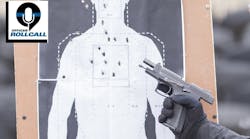By now Active Shooter training is as common in the law enforcement arena as plastic surgery is in Los Angeles. The law enforcement community has obtained a foot hold on how to respond to these incidents and understands that the traditional response of waiting for S.W.A.T. to assist is not an ideal option. Law enforcement's goal is now to enter and terminate the victim-creating-machine, the Active Shooter. This will require the entry team to bypass victims, explosive devices and even their own injured officers, with the mission to end the massacre.
Law enforcement was mandated to adjust their training based on historic criminal events. However, now that law enforcement has created a basic response on how to respond to the Active Shooter, what are departments doing to perfect the response? Sure we know the basics of the Active Shooter Response: go in and stop the threat. Debate may exist as to tactics, number of entry officers or ideal weapons, however the basic mission is clear. Having spoken to many law enforcement professionals through out the country about their Active Shooter training, their common concern is that we don't train enough.
Evidence from a variety of sources exists that highlight the importance of muscle memory. As trainers we know that two types of motor skills are essential for combat scenario: fine and gross motor skills. Fine motor skills allow us to manipulate a radio microphone, utilize a writing instrument and most importantly, for the Active Shooter scenario is to squeeze the trigger of a weapon. The second, gross motor skill focuses on moving large body parts. These parts are essential for skills, such as, running and suspect control.
Regardless of the motor skill, we know that muscle memory is shaped through repetition. The number of repetitions required to create an instantaneous reaction is subject to debate. One thing is certain: the familiarity of an action or event allows for the human body to become accustomed to that action/event. This reduces stress and allows for a desired outcome. So in perspective, the more you train for an Active Shooter engagement, the more familiar you will be with group movements, noise distractions, mental superiority, areas of weapons discipline and shot placement. Familiarity equates to lower stress, thus allowing operators to function in what is commonly known as condition orange or some may classify this state as the beginning of condition red. Regardless the given color code, conditioned individuals often maintain between 145-175 heartbeats per minute while achieving maximum performance. Operators' performance is directly correlated to their repetition of training.
Accepting this philosophy, the remaining question is why do departments limit Active Shooter training to annual training? Research has shown that a large portion of state and local police departments qualify only annually with their handguns; some do have semi-annual qualifications with their rifles.
Shot placement is probably the most important function of stopping an Active Shooter. From a litigated perspective, the majority of departmental civil suites arise from use of force complaints. Knowing this, the reoccurring question continues, why do departments only train annually with their ultimate force tool? Courts have repeatedly linked the amount of compensatory compensation to that of excessive, unauthorized or improper force techniques. As litigation relates to the Active Shooter, the victims often sue the department and/or officer. The emphasis of the suit is not what the officer did, rather what the officer did not do. It will focus on the actions or lack of actions of the officer and unfortunately not the Active Shooter.
Departments across the country have adapted their training regarding response to the Active Shooter scenario. Their training is credible, but is it enough? Take into account that most effective neutralization method to diffuse an engaged Active Shooter is by force. Conceiving that state and local law enforcement shoot their handguns only once a year in an environment that offers stationary or rotating targets, this clearly contradicts all training studies that highlight repetitive training yields desired results. An Active Shooter will probably not be stationary!
Conversations with officers from various departments highlight that the majority of departments training for the Active Shooter are basically the same. First the history of the Active Shooter is highlighted, then practical tactics are conducted and training is concluded with a wash down or debrief of the situation. Very little is discussed on the topics of site assessment, use of security cameras and maximizing duty gear.
For example, during the site assessment, if an Active Shooter has engaged in a school, have departments highlighted the increased disaster that may occur if that shooter enters the chemistry room, the auto shop or even the area where special needs children are taught? One member of a four person entry team, if you are lucky to have that many officers initially on scene for entry, can coordinate with school security and isolate the Active Shooter by utilizing school cameras if equipped to detect individual movement. They can also turn on interior school alarms with the assumption that the school is in lock down mode and an opening of a door will trigger an alarm, thus assist in identifying the location of the Active Shooter while the other team members engage.
In regards to maximizing duty gear, as law enforcement we understand that the Active Shooter incident will require the use of deadly force. Patrol officers typically carry three magazines with them, one in the weapon and two on their duty belt, total rounds in the area of 46: three 15-round magazines with one additional round chambered. An option for additional firepower is to acquire additional magazines from perimeter officers. Perimeter officers have greater options than entry officers if confronted by a threat, such as moving to cover, concealment and quicker backup. Furthermore, the odds favor that an engagement will occur inside the building rather than outside. These techniques are just a few that escalate the level of training and thought process that should be taught. We as a profession can not afford to become stagnate in our training philosophies. Although many departments justify this stagnation of additional training by citing increased financial costs, that is not a plausible justification. Regardless, individual officers, as well as, our community civilian partners alike must continuously challenge to better the departmental provided training and strive for excellence.
In conclusion, annual training of any kind, especially in the arena of the Active Shooter, is insufficient in achieving true proficiency and allows for greater litigation. The mythical training syndrome of annual training is not sufficient for modern law enforcement. Being a law enforcement officer requires the ability to become fluid and dynamic in every incident. Since the only constant in the criminal element is change itself, training is paramount. Critical incident success resolution is not from a program or stagnate training, rather, success is an end result of continued training and professional implementation.



